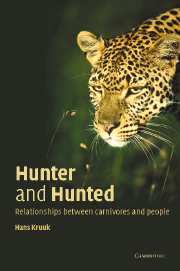Book contents
- Frontmatter
- Contents
- Preface
- 1 Turning the other cheek
- 2 Carnivore society: hermits and communes
- 3 The quarry of the hunter
- 4 Man the hunted
- 5 Competitors and carriers
- 6 History of a conflict
- 7 What is the use?
- 8 Wolves with human souls: pets
- 9 Carnivores and neighbours: effects on prey
- 10 Crying wolf: anti-predator behaviour
- 11 Carnivores in culture
- 12 The future
- Epilogue
- References
- Index
10 - Crying wolf: anti-predator behaviour
Anti-carnivore behaviour of animals and man
Published online by Cambridge University Press: 08 January 2010
- Frontmatter
- Contents
- Preface
- 1 Turning the other cheek
- 2 Carnivore society: hermits and communes
- 3 The quarry of the hunter
- 4 Man the hunted
- 5 Competitors and carriers
- 6 History of a conflict
- 7 What is the use?
- 8 Wolves with human souls: pets
- 9 Carnivores and neighbours: effects on prey
- 10 Crying wolf: anti-predator behaviour
- 11 Carnivores in culture
- 12 The future
- Epilogue
- References
- Index
Summary
Getting close to a wild carnivore can be an emotional experience, whether it be a fox or a lion. One feels that unique adrenalin-based chill in the spine, a slight fear, the overwhelming thrill of the animal's proximity and the knowledge of its abilities, its sharp teeth, speed and its strength, its possible aggression and the question of what it will do next.
Such an emotional response stems from our basic instincts about animals, and particularly about carnivores. These instincts are innate in even the most urbanized of people, and must have evolved to meet the fundamental ecological challenge of predators to our survival. In previous chapters I have discussed details of these threats from carnivores to ourselves and other animals. Here I want to describe the behaviour of a variety of species, including people, that are targets for predators, behaviour that we see in response to such threats.
The ecological effects of carnivores on ourselves, and on almost all mammals and birds have been, and still are, considerable. The next question, then, is about the behavioural response: exactly how do birds and mammals protect themselves? Do they learn how to cope with danger, and/or is there innate behaviour that evolved in response to selection pressures from predators? Seeing the vast range of beautifully adaptive behaviour patterns in animals facing all kinds of environmental challenges, one could also expect many behavioural adaptations to protect against the threat of predation.
- Type
- Chapter
- Information
- Hunter and HuntedRelationships between Carnivores and People, pp. 165 - 180Publisher: Cambridge University PressPrint publication year: 2002



